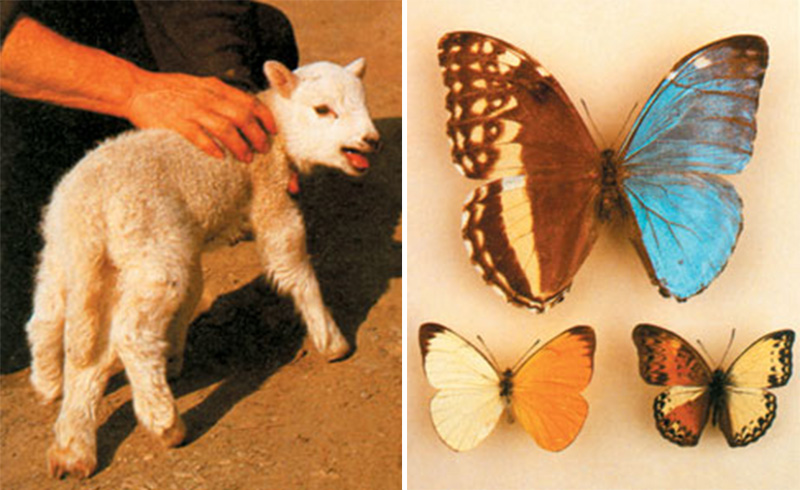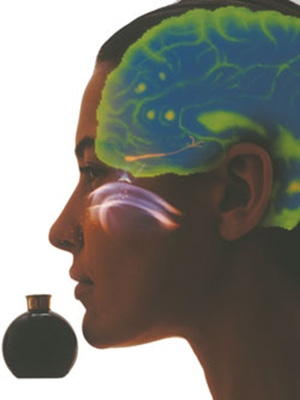Evolutionists Cannot Account for the Origin of the Sense of Smell
The theory of evolution was first proposed in the mid-1800s. Every since then, the theory has had only one aim: to suggest that science confirms its own claims. Tales about the slow stages by which similar creatures allegedly evolved from one another were all developed on the basis of this illusory groundwork. This "scientific" propaganda was expressed so persistently and so often that not only circles far removed from scientific circles, but also people who studied it began to attach to it an element of veracity. That is why what you may encounter in evolutionary tales is not scientific evidence, but imaginary scenarios decked out in scientific terminology.
There are some subjects, however, about which evolutionists find it difficult even to come up with scenarios. They have no hope of explaining how the soul, the brain’s perceptive ability, memory and the senses came into being in stages. That is because they are faced with the existence of metaphysical elements explicable only in terms of Creation, rather than a physical world about which they can make conjectures.
In evolutionist publications, therefore, the longest explanation on such subjects that you are likely to encounter read along the lines of “The brain emerged over time and began perceiving,” or “The nose emerged over time and began to smell.” You can never find any evidence or findings to confirm these assertions. Evolutionists, too, are well aware that they have no explanation to offer on the subject. They therefore emphasize points around which they can easily speculate, using the power of their imaginations, and never actually raise questions that they cannot explain in evolutionary terms.
Indeed, the extraordinary harmony between the smell system and the components that comprise that system, which we have examined so far, is one of those subjects that Darwinists are incapable of explaining—because in this magnificent olfactory system is exhibited the flawless creative Force of an infinite might. This matchless Creator is God, the Lord of the worlds. All the scientific research performed on the subject, all the evidence revealed, makes clear the truth of this perfection, despite the system’s complexity.
Evolutionists are also well aware of this. They aim, however, to deny the absolute existence of God despite the facts they see so clearly. Indeed, there is no other explanation for the illusory tales they come up with through falsehood and fraud, for which reason they have used the theory of evolution to deny the facts. However, their theory, with no scientific content, is unable to explain how existing mechanisms came into being. This chapter shall examine the answers to the groundless claims to which evolutionists cling as offered by science.
Evolutionist Scenarios Regarding Scent Perception
 |
In texts prepared by evolutionist researchers, the mechanism of the scent perception system is generally described in detail, following which it is maintained that this is “an evolutionary development.” The common view among evolutionists is along the lines that the ability to perceive scents is an entirely primitive one that appeared before the other senses. Organs and senses emerged as the need for them arose, and developed in accord with those needs. These claims, devoid of any foundation whatsoever, are expressed in these terms in evolutionist publications:
“Every each random affect in the outer world causes a certain change in organisms. (…) Every each cause leads to an effect and the consequence necessarily includes a piece of information related to its cause. One can not help to see and feel amazed at how the evolution, with its adaptation and discovery ability that is even hard to imagine, can employ this simple logical relation in biological reality for increasing the chances of its products’ survival."92
Expressions of this kind, lacking in any evidence, findings, or experimental or scientific evidence, have no significance other than seeking to justify claims based on chance. The way that they regard the sense of smell as the first sense and a primitive one, reflects this logic. The sole justification for this claim is that the other senses, such as sight or hearing, seem to possess more detailed systems and thus support the evolutionist progression of “from the simple to the more complex.” Proponents of Darwinism express the view in question in the following terms:
The sense of smell is a primal sense for humans as well as animals. From an evolutionary standpoint it is one of the most ancient of senses.93
The olfactory system is often described as the most “primitive” sensory system. Because of its early phylogenetic development and its connections to older, subconscious portions of the brain.94
Sense of smell is evolutionarily older than sight or hearing.95
At this point, it will be useful to remember that those who issued these statements are experts with a detailed knowledge of all the olfactory system’s mechanisms. They cannot be unaware of the system’s complexity and perfection. Nonetheless, they still have no hesitation at using the word “primitive” to refer to such a magnificent structure. That’s because a structure’s being primitive makes more tenable any claims of its forming by chance. They are unable to explain how any complex system could have come into being accidentally, but suppose that defending random developments for a simple structure will somehow seem more convincing.
 |
So on what scientific evidence do evolutionists base such a definitive judgment? How did the “primitive” sense of smell develop on what they refer to as the conditions on “the primitive Earth”? If you delve into this question, the response you find will run something like this:
In the ancient oceans on the primordial Earth, 3 billion years ago, a single-celled organism starting its daily life gave off organic chemical substances. These substances, unknowingly released by this tiny entity, left behind them traces, which were picked up by a predator. This predator crept up, attacked, and swallowed its luckless quarry. And in this way, the sense of smell set out on its long evolutionary process. Professor of Biology John T. Caprio of Louisiana State University states that initially, the sense of smell developed in order to identify amino acid-like chemical substances soluble in water. The ability to determine molecules floating in the air is an adaptation of that original mechanism.96
If the quotation above had begun "Once upon a time...", no doubt nobody would raise any objection to it. However, the paragraph appeared in an evolutionist publication, claiming to be scientific. This once again gives us an idea of the methods evolutionists employ in making their claims, and the kind of perspective they possess.
 |
| And He has subjected to you, as from Him, all that is in the heavens and on earth: Behold, in that are Signs indeed for those who reflect. (Surat al-Jathiyya: 13) |
It will be appropriate to undermine these claims, advanced in the name of science despite all their illogicality. In brief, what Caprio, an evolutionist researcher, wants to say is that single-celled organisms unknowingly released chemical substances; that predators detected these and hunted them. In addition to being exceptionally illogical, his conjecture fails to answer how the sense of smell came into existence. Absolutely no information is provided about the sensory systems that enabled predators to detect their single-celled prey. No explanation is offered of how the sensory systems came into being that permitted single-celled organisms to detect their enemies’ scents and thus survive. Neither are we told what “evolutionary” mechanisms entered the equation during the construction of this extraordinarily complex mechanism.
Evolutionists hesitate to go into detail, because their explanations are based on a single mechanism: chance.
Chance Cannot Bring into Being Any Structure in a Living Thing
No matter what detail on Earth you examine, you encounter the presence of a sublime Intellect. This makes crystal clear one very important truth: Our omniscient Lord created everything on Earth. Darwinists, on the other hand, claim that only coincidences possess any creative force—that uncontrolled, random events of their own gave rise to complex life, with its exceptionally delicate balances.
The “creative force” which Darwinists resort to in accounting for the origin of smell is, again, chance. A living thing felt the need to detect smells, for which reason the necessary organ developed—by chance—and proteins with specific molecular sequences formed in the structure of this organ —coincidentally—, and scent molecules with the same molecular formulae also arose. While the enormously complex nerves, able to provide perception from the nose to the brain, were also forming by chance, electrical signals were beginning to transmit those perceptions—again by chance.
 |
| The exceedingly complex sense of smell in hunting animals is a miracle of creation that evolutionists are totally unable to account for. |
In fact, it’s impossible for even one of the countless necessary phenomena to have taken place by chance, let alone a regular sequence of such coincidences. Nevertheless, an uncontrolled intervention apparently gave the system something new, and propelled it towards perfection. Evolutionists are forced to maintain that these chance events functioned perfectly, because any single error in any one component of a complex system will mean everything returning back to the beginning, and the system will be useless. Therefore, according to evolution, even though all events are uncontrolled and random, they still function perfectly.
 |
| Mutations that occur randomly are always harmful to living things. The above picture shows a lamb born with five legs and butterflies with impaired wing symmetry, again due to mutations. |
The “random phenomena” in question are actually random mutations—structural changes in a living organism’s genes resulting from external effects such as radiation. These changes constitute a grave danger if they are uncontrolled. Indeed, modern-day science has proved that mutations inevitably arise from an adverse effect on a living thing’s molecular structure. Ninety-nine percent of mutations are harmful, while the remaining 1% are neutral. Therefore, mutations are simply defects and impairments that occur in a living organism’s perfect design. Their effects are no different than that those of an earthquake striking a city constructed with enormous regularity and design. Yet a living organism possesses a structure much more complex and flawless than even the largest city.
 |
| Who hath created, and further, given order and proportion; Who hath ordained laws. And granted guidance; and Who bringeth out the (green and luscious) pasture, and then doth make it (but) swarthy stubble. (Surat al-A'la: 2-5) |
This being so, mutations cannot endow a living thing with anything new. Modern-day scientists admit as much, stating that mutations can have no evolutionary effect. Michael George Pitman, a professor of plant physiology, has this to say:
Do we, therefore, ever see mutations going about the business of producing new structures for selection to work on? No nascent organ has ever been observed emerging, though their origin in pre-functional form is basic to evolutionary theory. Some should be visible today, occurring in organisms at various stages up to integration of a functional new system, but we don’t see them: There is no sign at all of this kind of radical novelty. Neither observation nor controlled experiments has shown natural selection manipulating mutations so as to produce a new gene, hormone, enzyme system, or organ.97
Even Sir Julian Sorell Huxley, a prominent neo-Darwinist who first added the concept of mutation to Darwin’s claims regarding natural selection, admitted that mutations had no effect:
Obviously, such a process [species change through mutations] has played no part whatever in evolution.98
 |
Despite this evident truth, however, evolutionists still use mutations to account for the imaginary formation of all kinds of structures and functions. Despite mutations’ inevitably damaging effects, evolutionists claim that structures have simple properties so as to make their claims sound convincing. Again, that is why evolutionists insist on referring to the sense of smell as “primitive,” imagining that it’s easier to explain a primitive system arising as the result of chance. Yet this is a meaningless assumption. Even a primitive system still displays order, which coincidences cannot produce. In addition, not a single detail in this glorious universe created by God can be described as primitive.In contrast to evolutionists’ claims, the olfactory system described in the preceding chapters is a most complex, containing exceptionally delicate balances and flawless mechanisms and structure. In fact, research into the sense of smell reveals an evident conclusion: There is no such thing as a primitive sense. On the contrary, all findings reveal the existence of a most complex structure. For decades, thousands of scientists have sought to explain the olfactory mechanism, yet it is still understood only in general terms. The information about the details of the system consists of just supposition and theories.
One expert on this subject, Professor Linda B. Buck a Nobel Prize winner in 2004, makes this comment:
Smell is perhaps the most exquisitely sensitive and complex of all the senses, and it has also been the most perplexing for scientists to decipher.99
Heinz Breer of Stuttgart-Hohenheim University won the Leibnitz Preis, the most important science prize of Germany, for his work on the sense of smell. Professor Breer describes its importance in these terms:
Olfaction, the ability to recognize and discriminate myriad airborne molecules with great accuracy and sensitivity, is one of the most remarkable but least understood senses.100
Evolutionists’ efforts to portray such a complex mechanism as primitive are actually a way of denying the obvious truth they are faced with. They, too, witness that the olfactory mechanism’s superior creation clearly belongs to Omniscient and Almighty God. The fact that God creates within a certain order and measure, and that creation belongs to Him alone, is revealed in the Qur’an:
He to Whom the kingdom of the heavens and the Earth belongs. He does not have a son and He has no partner in the Kingdom. He created everything and determined it most exactly. But they have adopted gods apart from Him which do not create anything but are themselves created. They have no power to harm or help themselves. They have no power over death or life or resurrection. (Surat al-Furqan: 2-3)
Demolished Evolutionist Myths
 |
While maintaining that the olfactory mechanism developed gradually, evolutionists also claim that during the so-called human evolutionary process, the importance of smell declined in comparison with that of other senses. This claim is another distortion resorted to by evolutionists in order to suggest that there was a gradual development among the five senses. According to this claim, a living thing evolving over the course of time possesses senses that are increasingly advanced. However, they are unable to present any scientific evidence for this claim, and instead seek to adorn it with imaginary scenarios and scientific terminology.
First of all, the materials most frequently employed in purely conjectural evolutionist scenarios on the subject of so-called human evolution, clearly, are reconstructions—models, drawings and paintings based on the skulls of now-extinct apes that lived in the past. Evolutionists endow these skulls with various facial features, seeking to give the impression that “ape-men” once lived. They may impose a human face on an ape’s skull but leave a few simian details. The secret of making an ape resembling a human being is to give the desired shape to the soft tissues superimposed on the skull. That’s because your facial bones have little determining effect on the soft tissues that make up the mouth, nose and eyelids. Using such a method, therefore, an ape’s face can easily be made to resemble a human’s. It is for that reason that evolutionist sources are all full of half-man, half-ape drawings and pictures of models produced for that purpose.101
 |
| The fictitious reconstructions designed by evolutionists depict the nose as especially large and wide. |
You may have noticed that in these imagined, prejudiced reconstructions, the nose is generally flat and wide. In the fictitious passage from ape to man, the nose—deliberately portrayed as large and flat—needs to assume a human appearance over the course of time. For that reason, evolutionists conclude that the nose gradually shrank, losing much of its functionality. They openly deny all the complex and superior features of this splendid organ.
In fact, this contradiction indicates the dilemma in which evolutionists find themselves. For one thing, this claim entirely contradicts evolutionists' imaginary procession "from the primitive to the advanced." Evolution towards the advanced is reversed, and in some way, a retreat from perfection to the primitive was effected. In other words, chance thought that our other senses were more important and decided that various properties belonging to the nose were unnecessary. Believing in the evolutionists' account means believing this illogical claim.
In addition, the claim that the nose's complexity decreased over time has no scientific evidence at all behind it. In recent years, it has been realized just how irrational and unscientific this claim clearly is. All 21st-century scientific studies and research have revealed that the sense-perception system is of an extraordinary complexity, and evolutionists have therefore suffered a major disappointment. Also, it is increasingly evident that new scientific advances will continue to shatter evolutionists' dreams.
Statements From an Expert
 |
| And the things on this earth which He has multiplied in varying colours (and qualities): verily in this is a sign for men who celebrate the praises of Allah (in gratitude). (Surat an-Nahl: 13) |
The sense of smell—which evolutionists seek to portray as primitive compared to the other senses and which they claim can easily be accounted for in terms of chance—is actually a mechanism about which much is still unknown, and many of its complex details are still a mystery. Research and statements by present-day scientists on this subject make this crystal-clear. One who can be cited on this subject is the scientist Stuart Firestein of Columbia University, known for his research into the sense of smell and regarded as an authority in the field. In his articles Professor Firestein expresses the highly developed and complex nature of the sense of smell.
Some of the Professor Firestein’s statement reads as follows:
We use the vertebrate olfactory receptor neuron as a model for investigating general principles and mechanisms of signal transduction—receptor-ligand interactions, modulation by second messengers, ion channel gating, and the long term mechanisms of adaptation and desensitization. The olfactory neuron is uniquely suited for these studies since it is designed specifically for the detection and discrimination of a wide variety of small organic molecules, i.e. odors.
The most recent work in the lab utilizes Adenovirus vectors to drive over-expression of cloned odor receptors in olfactory neurons. Because odor receptors make up the largest family of G-protein coupled receptors (also including many neurotransmitter ands hormone receptors) they are excellent receptors to try and understand the relation between amino acid sequence and ligand binding affinities. We are able to over express particular receptors as well as receptor clones with targeted mutations and then screen these for specific ligand sensitivities. These data are then included in computer models of the protein receptor to understand precisely why one receptor is able to recognize the odor of say, roses, while another is specific for pizza.
In another vein, olfactory receptors are unique among neurons for the ability to regenerate throughout an animal’s life. Several experimental manipulations have been developed to induce neuronal regeneration and proliferation in vivo allowing one to harvest neurons with a known date of birth. By applying physiological techniques for cell recording we are quantifying biophysical parameters, such as the appearance of ion channels or receptors and the development of synaptic contacts, in developing neurons.102
From all his statements, only one meaning can be extracted: Very little is actually known about the sense of smell, even at the science’s present advanced level. The conclusion from all the resources that have been mobilized and the research carried out is that much of what is known is still theoretical. What’s known, however, is the magnificent structure of the olfactory system. Indeed, Stuart Firestein draws attention to this in the abstract section of his paper:
The mammalian nose is arguably the best chemical detector on the planet, capable of detecting and discriminating among many thousands of compounds.103
The truth is therefore this: the sense of smell is exceedingly complex, an extraordinary mechanism that cannot be explained in terms of such hollow concepts as chance, mutation or natural selection. The flawlessness of the sense of smell is one of the signs of God’s perfect creation, made by the Lord of infinite knowledge and might.
The Sense of Smell's Irreducible Complexity
 |
| And enclosed Gardens, dense with lofty trees, And fruits and fodder, For use and convenience to you and your cattle. (Surah 'Abasa: 30-32) |
One fact revealed by Professor Michael J. Behe of Lehigh University is that science has discovered irreducible complexity in living organisms. This term means that all systems, from largest to the smallest, possess an exceedingly wide-ranging complexity; and within these, there is such order that not even one component can be dispensed with. In order for an organ to function, not even a single one of the components that compose it can be omitted. Otherwise, the organ will fail to function.
This scientific fact totally undermines all the claims of the theory of evolution, because irreducible complexity makes impossible the gradual development expounded by evolutionists. It is impossible, for example, for the eye’s 40 different components to form individually and gradually, since unless all 40 are complete, the eye cannot function. Again according to the theory of evolution, a functionless organ will be eliminated through natural selection.
Under these conditions, the same question for evolutionists arises with regard to other complex organs. The sense of smell—that superior mechanism that we’ve been examining so far—also possesses irreducible complexity. In order for scents to be perceived, the micro-hairs, receptors, scent receptor cells, scent cells, pain receptor cells, olfactory bulb, mucus secretion, basal cells, special protein and enzymes and a great many other factors need to be present together, all at the same time and fully formed.
Yet even if all these details do come together, the system is not yet complete. It is essential that the nose should perceive the smells it receives. For that reason, the human brain, described as “the most complex structure in the known universe”104 must also be present. Unless all these components are present together, this complex system will have no meaning at all.
 |
| When we detect a pleasant perfume, a number of consecutive and highly complex processes take place in our heads. |
It is impossible for any evolutionary process to have occurred in a system like this, which can in no way be reduced to any simpler form. Scent-receptor cells will serve no purpose in the absence of micro-hairs. In the absence of nerves, the signals received will fail to reach the perception center. If a single link in this chain—all of which operate together in separate areas—is removed from the equation, then no odor will be perceived in the brain. Therefore, this system must have emerged at once, with all its components fully formed. In order to detect one or 10,000 scents, all the elements cited above must be present, working in harmony together with one another. This points to a manifest truth: God created this mechanism, with all its flawless features, as He did everything else in the universe.
Darwinists’ insistence on the subject of gradual evolution, despite all its illogicality, stems from their unwillingness to accept this. So long as they deny that there is a Creator Who created all living things together with all their features, they can never escape from the impasse in which they find themselves.
Yet the truth revealed by God is crystal clear. God makes His existence clear through the incomparable beauties and designs He has created. The way that evolutionists oppose this fact, despite having no evidence with which to do so, doubtless results from this world being a place of testing. As revealed in Surah Saba’, 21; God created this world "... to know those who believe in the Hereafter from those who are in doubt about it...” Those who refuse to believe in the Hereafter will continue to manufacture lies in order to deny God’s superior creation. And those who believe in His existence will prepare from themselves a place in Paradise where they will enjoy the greatest pleasures from the beauties they see.
This, of course, is the greatest salvation. It is revealed in the Qur’an that:
But those who believe and do right actions will have Gardens with rivers flowing under them. That is the Great Victory. (Surat al-Buruj: 11)
Footnotes
92. Hoimar Von Ditfurth, Im Anfang War Der Wasserstoff 3 (In the Beginning was Hydrogen 3), 2nd edition, February 1997, Alan Publishing, p.134. ![]()
93. John C. Leffingwell, “Olfaction,” 2001, http://www.leffingwell.com/olfaction.htm. ![]()
94. Marjorie A. Murray, “Our Chemical Senses: 1. Olfaction,” 2001, http://faculty.washington.edu/chudler/chems.html. ![]()
95. P. Whitfield, D.M. Stoddard, Hearing, Taste, and Smell; Pathways of Perception, New York: Torstar Books, Inc., 1984; (http://www.macalester.edu/~psych/whathap/UBNRP/Smell/nasal.html) The Olfactory System: Anatomy and Physiology, Macalester College, 2001. ![]()
96. “How The Nose Knows: Research On Smell Boosted,” Science Daily Magazine, 24 May 1999, http://www.sciencedaily.com/releases/1999/05/990524040220.htm. ![]()
97. Michael G. Pitman, Adam and Evolution, London: River Publishing, 1984, pp. 67-68; http://www.pathlights.com/ce_encyclopedia/10mut06.htm. ![]()
98. Sir Julian Sorell Huxley, Major Features of Evolution, ttp://www.pathlights.com/ce_encyclopedia/10mut06.htm. ![]()
99. “Researchers Discover How Mammals Distinguish Different Odors,” Howard Hughes Medical Institute News, 1999, http://www.hhmi.org/news/buck.html. ![]()
100. Heinz Breer, “Olfaction,” Encyclopedia of Life Sciences, August 1999. ![]()
101. Earnest A. Hooton, Up From The Ape, New York: Mcmillan, 1931, p. 332; http://www.-acs.ucsd.edu/~idea/humanquotes.htm. ![]()
102. Stuart J. Firestein, http://www.columbia.edu/cu/biology/faculty-data/stuart-firestein/faculty.html. ![]()
103. Stuart J. Firestein, “A Code in the Nose,“ Science, 6 April 2004. ![]()
104. G. Fischbach, “Dialogues on the Brain: Overview,” The Harvard Mahoney Neuroscience Institute Letter, 1993, Vol. 2. ![]()
- Introduction
- The Creation in the Olfactory System
- Mechanisms within the System
- What Odors and the Olfactory System Suggest
- Animals' Sense of Smell
- Evolutionists Cannot Account for the Origin of the Sense of Smell
- Technology in the Olfactory System
- The Perfect Creation in the Taste System
- Conclusion
- The Deception of Evolution
